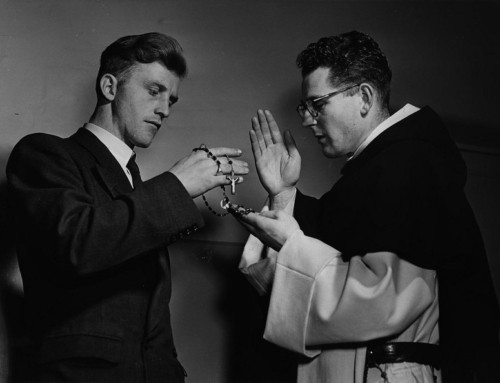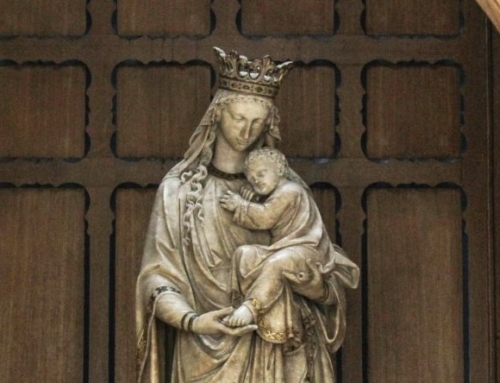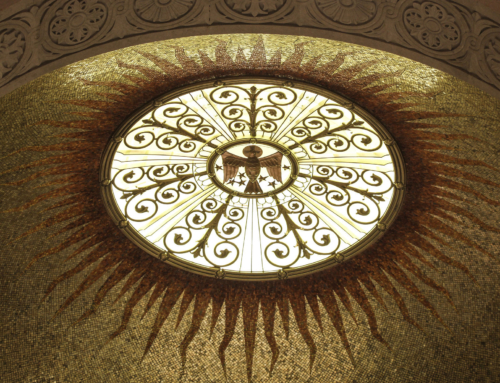William J. Farge, S.J., A Christian Samurai: The Trials of Baba Bunko. Washington: The Catholic University of America Press, 2016.
Jesuit Father William Farge presents a book that challenges the dominant secular narrative among scholars of Japanese history regarding the presence of Christianity in early modern Japan. Though essentially an academic book, A Christian Samurai is geared even to the most uninformed reader such that anyone could put down the book and feel as though he were well-versed in Japanese history and culture.
Farge’s aim is to force his colleagues (with evidence too striking to ignore) to re-examine the present consensus that Christianity had disappeared from Japan by 1650 and that it had no lasting effect on Japanese culture. The evidence he presents is the fruit of careful and highly analytical research into the writings of an 18th century political satirist named Baba Bunko who—at a time when Christianity is supposed to have been eradicated—criticized the ruling elite for failing to meet absolute moral standards. He was executed for his writings in 1759. The standards that Bunko demands bear no relation to any moral system practiced in Japan at that time or previously; the only explanation is that Bunko was influenced by Christian doctrine, with which he demonstrates intimate familiarity.
Farge begins with a brief but thorough treatment of the history of Christianity in Japan and the circumstances in which it was suppressed. He describes three major characteristics of Japanese society which were in force from 1603 until 1868, during the reign of the shoguns of the Tokugawa dynasty. First, the country was divided by a strict social hierarchy ruled by the samurai class of military nobility, headed by the shogun and his bakufu (Japanese for “government”) who governed from Edo (present-day Tokyo). Second was the strict policy of isolationism begun by the shogun in 1633, which barred both entrance and exit into the country. Third, as a result of this policy, there was an intense persecution of Catholicism—due to fear of foreign invasion and influence—such that after 1650 Christianity was, supposedly, eradicated.
Farge indicts the contemporary academy for failing to explore evidence of Christians being in Japan between 1650 and 1868 because “it would not be consistent with the thesis of missionary failure and the subsequent demise of Christianity in Japan that has been constructed” (5). He admits that the sources are scarce; but this is no reason for ignoring those that do exist. Demonstrating his deep knowledge of manuscripts from the period, he discusses many examples from the intervening centuries which suggest that Christianity was anything but eradicated. The most striking of these was the discovery by Fr. Petitjean—the French missionary serving the newly allowed western merchant community—of 50,000 Christians in 1865 “whose descendants had been in hiding for over 200 years” (5).
The importance of showing that Baba Bunko’s writings contain great respect for and familiarity with Christianity, Farge argues, is that he was “the only writer to be executed by the bakufu during the Tokugawa period specifically for his writings” (7). Farge provides detailed literary analysis and engagement with current scholarship in literature and philosophy to make the convincing argument that Bunko was a Christian and therefore Christianity could not have been completely eradicated.
Bunko was “the only person in the middle of the 18th century to give written evidence of having understood certain elements of Christianity, such as the Eucharist, that would have been unfamiliar to anyone who was not a Christian” (12). This understanding is evident in various examples throughout Bunko’s writing. In his essay “A Collection of Useless Grumblings,” for instance, he “first advances the opinion that Buddhist and Shinto prayer are ‘exceedingly pointless,’ but Christian prayer, on the other hand, has the characteristics of ‘good prayer’” (38). These characteristics are faith, devotion, and a good text to pray (39). Bunko also “referred to the flag of the Shimabara [Catholic] rebellion as ‘the principal image of the Christian Lord of Heaven,’ which ‘should replace the imperial and shogunal crests.’ The banner, which he describes as ‘the body of a person,’ was actually a representation of the host and chalice of the Catholic Eucharist” (217). This reference, Farge asserts, is evidence of a “clear Catholic understanding of” and appreciation for the doctrine of the Eucharist (217).
Baba Bunko gives further evidence of Christian inclinations in his particular understanding of morality. In his essay “Contemporary Edo: An Album of One Hundred Monsters,” Bunko derides the elite for immoral behavior, denouncing such people as “monsters.” He relates various cases of bribery of high governmental officials [e.g., Hotta Masasuke (115)], the sexual promiscuity of Buddhist monks [e.g., Donkai Shuten (188)], and even the weakness and dishonesty of the reigning shogun. Bunko accuses this ruler, Shogun Tokugawa Ieshige, of neglecting his people in favor of “an inordinate amount of drinking and sexual practices” and then covering it up with the excuse of a false illness (108). Farge, remarking on Bunko’s stylistic ability, describes how “Bunko relates the poor state of the shogun’s health in highly formal language, using classical grammatical constructions. The contrast between the beautiful language and the base demeaning content makes the piece quite satirical” (108).
Bunko’s constant criticism of “the immorality of the samurai and members of the elite governing class of the Tokugawa bakufu”—and therefore a criticism of the Confucian morality to which everyone at the time subscribed—is an indication that Bunko himself subscribed to a completely different morality (15). He shows that Confucianism, Buddhism, and Shinto were failed systems because those who were supposed to be its enlightened and virtuous classes were actually hypocritical and depraved.
Bunko, further, showed a particular concern for oppressed peasants and exploited “courtesans” which was unprecedented for the time and culture. He clamors for justice for the 500,000 peasants of Gujo who—because of their resistance to the oppressive taxes of their local samurai lord Kanamori Yorikane—were arrested and banished to the mountains some fifty miles from their village; most starved to death en route during the “particularly severe winter of 1755” (63).
Bunko’s final break from the ethics of Confucianism lies in his demonstration of concern for the poor and in his advocacy for the “just treatment of the eta, the outcast class. He would declare that the government has the responsibility to aid the poor, feed the hungry, and treat the ill” (128), and he praised a high governmental official named Matsudaira Takechika who advocated for such policies (113). Farge notes that “these are all themes derived from Christianity and are not found in Japanese discourse of the middle eighteenth century or earlier” (128). Where, he asks, could Bunko have learned these values if not from Christianity?
For all his denunciation of its officials, however, the government “had not seemed particularly interested in Bunko or his writings up to the time he was apprehended” (77). For nearly five years he was allowed to go about his business like the many other political satirists of the day. Farge produces the text of Bunko’s conviction to explain this sudden change. In 1759 the bakufu high court declared that Bunko’s guilt lay in “spreading views that are strange and unconventional (isetsu nado)” for which the penalty prescribed was exile (81). “However,” the court continues, “since he has long been critical of the shogunate and has no respect for officials, he is to be imprisoned and executed” (81). Farge comments that the crimes of criticizing the government and disrespecting officials were not capital offenses, and even if Bunko’s case had been an exception, “he would have been the only person in Edo to suffer death for such a reason” (84). Thus it is unlikely that these were the crimes for which he was condemned; but the spreading of views that were “isetsu nado” is another matter entirely. This can be the only justification for the death sentence, which seems to have been purposely left vague and undefined. Farge cites a present-day Japanese scholar who points out that “the term ‘isetsu nado’ was sometimes applied to the crime of being a Christian” which was a capital offense (82). In order to avoid a public execution for an accusation of practicing Christianity—because the government was embarrassed that its one hundred and thirty years of persecutions were ineffective—the authorities would, instead, have issued the “vague charge of holding ‘strange and unconventional’ views” (83).
Baba Bunko’s moral principles applied to all people, no matter their social position, and in all circumstances; but, because his writings “reflect a moral perspective that modern scholars have assumed was nonexistent in the works of Tokugawa period writers,” the possibility is now raised that he could well have been a Christian (238). In illuminating this possibility, Fr. Farge issues a challenge to historians of Japan to “reevaluate the entire period” so as to determine whether they have created a “Tokugawa history that ignores some important historical and literary artifacts” which do not fit easily into the standard narrative (238). The question now is: will they take up his challenge?
✠
Download a PDF of this review HERE



